NFI Group Inc.
 | |
| Public | |
| Traded as | TSX: NFI |
| Industry |
Manufacturing Automotive |
| Founded | 1930 (as Western Auto and Truck Body Works Ltd) |
| Founder | John Coval |
| Headquarters | Winnipeg, Manitoba, Canada |
Area served | North America |
Key people | Paul Soubry ( CEO) |
| Products | Heavy-duty transit buses |
| Subsidiaries |
ARBOC Specialty Vehicles Motor Coach Industries NFI Parts |
| Website |
www |
NFI Group Inc.[1] is a Canadian multinational automotive company specializing in the manufacturing of heavy-duty transit buses and motorcoaches and the distribution of aftermarket parts. Its headquarters are in Winnipeg, Manitoba, with manufacturing, distribution and service centers in both Canada and the United States. New Flyer manufactures integral buses, building both the coachwork and the supporting chassis. The company currently sells vehicles under three brands: New Flyer Xcelsior transit buses, offered with various drive systems and in several lengths; ARBOC Specialty Vehicles small and mid-sized transit buses; and Motor Coach Industries (MCI) D-Series and J-Series motorcoaches. It also sold Daimler’s Setra S407 and S417 coaches until 2018.
New Flyer is the largest bus and coach manufacturer and distributor in North America and employs approximately 5,400 people at more than a dozen facilities. The company had a 45% market share of all heavy-duty transit buses and a 39% market share of all motorcoaches produced for North America in 2016. It is listed on the Toronto Stock Exchange under the symbol NFI, and is a constituent of the S&P/TSX Composite Index.
History
Early years
.jpg)
New Flyer was founded by John Coval in 1930 as the Western Auto and Truck Body Works Ltd. Reflecting an increased focus on bus manufacturing, it changed its name in 1948 to Western Flyer Coach.
In the 1960s, the company further focused on the urban transit bus market. In 1971, the then-financially struggling Western Flyer was sold to the Manitoba Development Corporation, an agency of the Manitoba government, and renamed Flyer Industries Limited.[2]
On July 15, 1986, Jan den Oudsten, a descendant of the family who formed Dutch bus manufacturer Den Oudsten Bussen BV, purchased Flyer Industries from the Manitoba government, changing its name to New Flyer Industries Limited.
A new beginning
Under new leadership, New Flyer developed, tested, and introduced several innovative designs. The company designed and tested North America's first low-floor bus in 1988 and delivered the first production model, called the D40LF, to the Port Authority of New York and New Jersey in 1991.[3] In 1994, New Flyer delivered the first compressed natural gas bus in North America and the world's first hydrogen fuel cell powered bus. In 1995, the company delivered the first low-floor articulated bus in North America to Strathcona County Transit.
In March 2002, New Flyer was acquired by KPS Capital Partners, an investment company that specializes in turning around struggling businesses. Later that year Jan den Oudsten retired as CEO. He was later inducted into the American Public Transportation Association's Hall of Fame for his work at the company.
In 2003, King County Metro in Seattle placed an order for 213 hybrid buses, the world's first large order for hybrid buses.[4]
On December 15, 2013, New Flyer was purchased by private equity firms, Harvest Partners and Lightyear Capital. The company's CEO, John Marinucci, called the purchase an indicator that the company's operational and financial turnaround had been accomplished. On August 19, 2005, New Flyer became a publicly traded company on the Toronto Stock Exchange.
2005 also saw a restyling of New Flyer's popular low-floor coaches with new front and rear endcaps, to modernize and streamline the exterior appearance of the bus.
In October 2008, New Flyer was named one of Canada's Top 100 Employers, which was announced in The Globe and Mail newspaper, and the company was featured in Maclean's newsmagazine. Later that month, New Flyer was also named one of Manitoba's Top Employers, which was announced by the Winnipeg Free Press newspaper.[5]
The company converted to a corporate structure from a trust-like structure in October 2011.
In May 2012, New Flyer and Alexander Dennis announced a joint venture to design and manufacture medium-duty low-floor bus (or midi bus) for the North American market. The bus, called the New Flyer MiDi was based on the design of the Alexander Dennis Enviro200. Alexander Dennis engineered and tested the bus, and it was built and marketed by New Flyer under contract.[6] During the partnership around 200 buses were delivered to 22 operators in Canada and US. In May 2017, New Flyer and Alexander Dennis announced their joint venture would end and production of the bus would transition to Alexander Dennis' new North American factory in Indiana where it is produced alongside the double-deck Enviro500 series bus.[7][8]
In June 2012 New Flyer, in a joint venture with Mitsubishi Heavy Industries, the Manitoba Government, Manitoba Hydro and Red River College, unveiled a fully electric battery-powered bus.[9]
Brazilian bus manufacturer Marcopolo S.A. acquired a 19.99% stake of New Flyer on January 23, 2013 for $116 million, the maximum it could acquire without offering to buy out other shareholders.[10]
As competing manufacturer Daimler exited the North American market, New Flyer purchased the aftermarket parts business for its Orion brand of heavy-duty transit buses for $29 million.[11] New Flyer also agreed to take on two outstanding bus manufacturing contracts for New York City Transit and the other for King County Metro in Seattle (giving New Flyer a total of 194 firm bus orders and options for an additional 291 buses). Under the agreement, New Flyer acquired the Orion parts inventory, the company's accounts, license to use proprietary part designs and agreed to provide parts for customer warranty support.
On June 21, 2013, New Flyer agreed to acquire competing heavy-duty transit bus manufacturer, North American Bus Industries (NABI).[12][13] Upon completion of NABI's outstanding orders, New Flyer converted the former NABI factory in Anniston, AL into a fourth facility to produce the Xcelsior heavy-duty transit bus.
In November 10, 2015, New Flyer agreed to acquire motorcoach manufacturer, Motor Coach Industries from KPS Capital Partners for US$459 million,[14] with the deal closing on December 18, 2015.[15]
On September 22, 2016, Marcopolo S.A. reduced its stake in New Flyer to 10.8%, although it remains the largest individual shareholder.
On December 1, 2017, New Flyer acquired small and mid-sized bus manufacturer ARBOC Specialty Vehicles for US$95 million.[16]
Bus models
Model designations
Current New Flyer model numbers are composed of a model code, a power source code and the length of the bus. Note that not all possible combinations have been offered.
Current production model
| Model | Power | Length |
|---|---|---|
| X = Xcelsior | D = diesel DE = diesel-electric hybrid E = battery-electric H = hydrogen fuel cell N = compressed natural gas T = electric trolleybus |
30 = 30 feet (9.1 m) 35 = 35 feet (11 m) 40 = 40 feet (12 m) 60 = 60 feet (18 m) articulated |
| Model | Length | Width | Introduced | Notes | Photo |
|---|---|---|---|---|---|
| Xcelsior[17] | 35 feet (11 m) 40 feet (12 m) 60 feet (18 m) |
8.6 feet (2.6 m) | 2008 |
|
XDE40 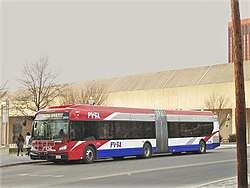 XDE60 |
Discontinued models
| Prefix | Power | Length | Suffix |
|---|---|---|---|
| none = conventional M = MiDi |
C = compressed natural gas D = diesel DE = diesel-electric hybrid E = electric trolleybus F = fuel cell GE = gasoline-electric hybrid H = hybrid diesel-electric HE = hydrogen hybrid-electric L = liquefied natural gas |
30 = 30 feet (9.1 m) 35 = 35 feet (11 m) 40 = 40 feet (12 m) 41 = 41 feet (12.5 m) 60 = 60 feet (18 m) articulated |
none = high-floor (older) or MiDi HF = high-floor (newer) i = Invero (low-floor) LF = low-floor LFA = low-floor advanced LFR = low-floor restyled S = suburban high-floor |
| Model | Introduced | Discontinued | Maximum Seats |
Notes | Photo | |
|---|---|---|---|---|---|---|
| MD30/MD35 MiDi |
2013 | 2017 |
|
_1415_Phlash_bus.jpg) | ||
| C40/C40HF D40/D40HF L40/L40HF |
1987 | 1999 |  | |||
| D35/D35HF | 1988 | 1997 | ||||
| D60/D60HF E60/E60HF Galaxy |
1988 | 2006 | The E60 was only built from 1992 to 1994 for the San Francisco Municipal Railway. |  | ||
| D40S | 1988 | 1994 | A suburban version of the D40; manufactured only for GO Transit. | |||
| C30LF D30LF |
1996 | 2009 | 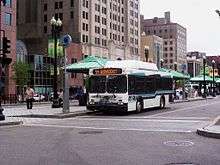 | |||
| C35LF D35LF DE35LF L35LF |
1996 | 2009 | Sold in the United States only. |  | ||
| C40LF D40LF DE40LF F40LF GE40LF L40LF |
1989 | 2013 | Adapted from the Den Oudsten B85. One D40LF demo unit was built in 1989 for the Port Authority of New York and New Jersey. |
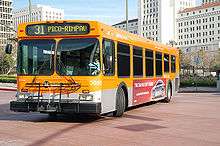 | ||
| D60LF DE60LF |
1997 | 2010 | The DE60LF was only sold in the United States. |  | ||
| D45S Viking |
1998 | 1999 | 104 units built for MTAs of Houston, Texas (METRO) and New York City (NYCTA). |  | ||
| D40i DE40i Invero |
2001 | 2007 | One of the largest customers was OC Transpo (Ottawa, Ontario). Only a small number of DE40i (hybrid diesel/electric) versions were produced, all for Roaring Fork Transportation Authority (Aspen, Colorado). |
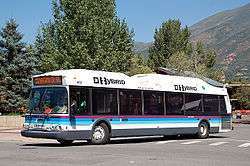 | ||
| DE35LFA D40LFA C40LFA DE40LFA GE40LFA D60LFA DE60LFA |
2005 | 2010 | 35LFA available only in DE, 40LFA available only in C, D, DE or GE, 60LFA available only in D or DE versions, for BRT. Only 42 Examples of the GE40LFA were built, all for Long Beach Transit (Long Beach, California). |
 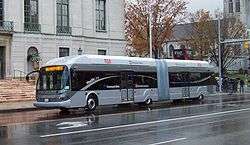 | ||
| C30LFR DE30LFR |
2005 | 2014 | While the C30LFR was ordered by the Metropolitan Atlanta Rapid Transit Authority, it was never built. The order was cancelled in favour of the XN35. | |||
| C35LFR D35LFR DE35LFR GE35LFR |
2005 | 2014 |
| |||
| C40LFR D40LFR DE40LFR E40LF E40LFR GE40LFR H40LFR HE40LF L40LFR |
2005 | 2014 | The E40LF was an electric trolley demo built in 2005 for Coast Mountain Bus Company. The HE40LF was a hydrogen-electric hybrid demo built in 2006 for SunLine Transit Agency. |
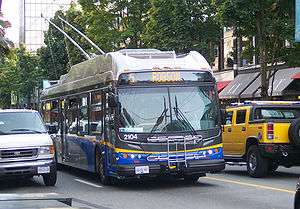 | ||
| D60LFR DE60LFR E60LFR |
2005 | 2014 | Coast Mountain Bus Company was the only purchaser of the E60LFR. | _on_H-1_Freeway_2011-01-04.jpg) | ||
| DE41LF | 2007 | 2009 | 220 units built for the Southeastern Pennsylvania Transportation Authority (Philadelphia, Pennsylvania), and five for the Hamilton Street Railway. |  | ||
Flyer Industries Limited A and B suffixes denoted update versions. | ||||||
| D700 D700A |
1968 | 1974 | 53 | Similar in appearance to the Flxible New Look. |  | |
| E700 E700A |
1968 | 1973 | 53 | Trolleybus version of the D700/D700A. D700A shells sold to the Toronto Transit Commission (Toronto, Ontario) to reuse components from Canadian Car & Foundry-Brill T48 and T48A trolleybuses.[18] |
 | |
| D800 D800B |
1974 | 1981 | 53 | Based on the AM General Metropolitan, which itself was an updated version of the D700.[2] Offered in -9635 (96 inches [2.4 m] × 35 feet [11 m]) and -10240 (102 inches [2.6 m] × 40 feet [12 m]) versions. |
 | |
| E800 E800A |
1974 | 1978 | 53 | Trolleybus version of the D800/D800B. Notable operators of the E800 were the Massachusetts Bay Transportation Authority (Boston, Massachusetts) and San Francisco Municipal Railway (San Francisco, California). The E800A was delivered only to the Hamilton Street Railway (Hamilton, Ontario). | 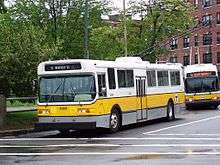 | |
| D900 | 1978 | 1980 | 53 | |||
| D901 D901A |
1980 | 1986 | 53 | Revised front with rounded corners. |  | |
| E901A E902 |
1982[19] | 1983[19] | 53 | A total of 245 units of this trolleybus were built,[19] all for BC Transit (Vancouver, British Columbia). Initially desginated model E901A, production continued as model E902, which may be identical. (No differences between the E901A and E902 have ever been identified.)[20] Eighty E901A and E902 buses were sold to EPTM (Mendoza, Argentina) in 2008. |  | |
| D902 | 1984 | 1984 | 53 | This model was only built for San Francisco MUNI. | 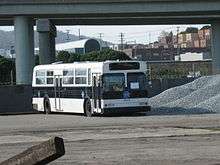 | |
| D2001 | 32 | A 30-foot (9.1 m) version of the D900 that was announced but never built. | ||||
| Western Flyer | 1941 | 1941 | Front engine highway coach; no official model name. | |||
| T-28 | 1945 | 1945 | 28 | highway coach | ||
| T-32 | 1945 | 1959 | 32 | gasoline engine highway coach | ||
| T-36 | 1950 | 1955 | 36 | standard highway coach | ||
| T36-2L | 1955 | 1955 | 36 | split-level 40-2L body | ||
| Canuck | 1953 | diesel rear engine prototype | ||||
| P-37 Canuck | 1955 | 37 | gasoline rear engine | |||
| C-40 | 1949 | 1955 | 40 | intercity coach | ||
| T-40 | 1949 | 1955 | 40 | transit version of the C-40 | ||
| P-37 Canuck | 1955 | 1958 | 37 | intercity coach | ||
| P-41 Canuck | 1958 | 1964 | 41 | diesel rear engine intercity coach | ||
| D500 Canuck | 1964 | 1967 | 37 | 31 feet (9.4 m) diesel rear engine | ||
| D600 Canuck | 1967 | 1968 | 45 | 38 feet (12 m) lengthened version of D500 | ||
| Buda Lo-525 | 1937 | 1941 | 32 | First bus produced by company; sold to Grey Goose Bus Lines (Winnipeg, Manitoba). | ||
Source: New Flyer Industries Inc.
Facilities
Manufacturing Facilities
New Flyer operates four facilities where new transit buses are manufactured.
Of these facilities, the Winnipeg, St Cloud, and Anniston facilities have full production capability. The Crookston facility performs final assembly on buses from shells that are shipped from Winnipeg.
Specialty bus manufacturing
- Middlebury, Indiana - part of ARBOC purchase [21]
Parts Distribution Centers
New Flyer operates five facilities that distribute parts to customers. Some of these parts are built by New Flyer and some are OEM parts, built by other companies. The centers are geographically spread out to offer ground delivery service within two-days to all of the US and Canada.[22] These facilities also provide parts for both Orion and NABI buses, after New Flyer purchased NABI and acquired the Orion parts business from Daimler in 2013.[23]
- Winnipeg, Manitoba
- Brampton, Ontario
- Hebron, Kentucky
- Fresno, California
- Delaware, Ohio
Bus Component Fabrication
New Flyer operates facilities that fabricate the components used to build buses. TCB Industries is a wholly owned subsidiary that makes components for both New Flyer and other manufacturers.[24]
- Winnipeg, Manitoba
- Jamestown, New York
- TCB Industries –
- Shepherdsville, Kentucky
- Elkhart, Indiana closing in 2018 [25]
Service Centers
New Flyer service centers are typically located in regions with the company's biggest customers. For these customers, New Flyer performs final assembly, pre-delivery inspection, acceptance, and training services for new buses. The Arnprior center also offers maintenance services for any make and model, including mid-life overhauls and collision repair.[26]
References
- ↑ "NFI Group". New Flyer.
- 1 2 Stauss, Ed (1988). The Bus World Encyclopedia of Buses. Woodland Hills, CA (USA): Stauss Publications. ISBN 0-9619830-0-0.
- ↑ "New Flyer - History". www.newflyer.com. Retrieved 2017-08-09.
- ↑ "New Flyer Receives Order for Up To 715 Buses From King County Metro" (Press release). New Flyer Industries Inc. May 16, 2007. Archived from the original on August 12, 2007. Retrieved 2017-07-13.
- ↑ "Reasons for Selection, 2009 Canada's Top 100 Employers Competition".
- ↑ "Industry News: New Flyer In Bus Joint Venture". Diesel Progress. Waukesha, Wisconsin. May 10, 2012. Archived from the original on May 31, 2012.
- ↑ "New Flyer and Alexander Dennis Agree to Transition MiDi® Bus to North American-Based Alexander Dennis Inc". New Flyer. May 10, 2017. Retrieved May 26, 2017.
- ↑ Enviro200 joint venture terminates Buses issue 748 July 2017 page 21
- ↑ Kusch, Larry (June 2, 2012). "New Flyer green leader". Winnipeg Free Press. Retrieved 2017-07-13.
- ↑ The Canadian Press (January 23, 2013). "Brazilian bus maker loads up stake in New Flyer Industries". The Globe and Mail. Retrieved 2017-07-13.
- ↑ "New Flyer buys Orion parts business of Daimler Bus". The Globe and Mail. 2013-03-01. Retrieved 2013-04-22.
- ↑ "New Flyer confirms the successful closing of North American Bus Industries, Inc. acquisition and related financial transactions" (PDF) (Press release). New Flyer Industries. June 21, 2013. Archived from the original (PDF) on January 24, 2014. Retrieved 2017-07-13.
- ↑ "Archived copy". Archived from the original on 2013-06-26. Retrieved 2013-06-30.
- ↑ "New Flyer buys Motor Coach Industries for $604M Cdn". CBC News. November 10, 2015. Retrieved 2017-07-13.
- ↑ "New Flyer Industries Investor Presentation" (PDF). www.newflyer.com. January 14, 2016. Retrieved August 8, 2017.
- ↑ "New Flyer acquires ARBOC Specialty Vehicles". New Flyer Industries. December 1, 2017. Retrieved 2018-06-03.
- ↑ New Flyer Xcelsior info
- ↑ Sebree, Mac; and Ward, Paul (1974). The Trolley Coach in North America, pp. 329–332. Los Angeles: Interurbans. LCCN 74-20367.
- 1 2 3 Murray, Alan (2000). World Trolleybus Encyclopaedia. Yateley, Hampshire, UK: Trolleybooks. p. 96. ISBN 0-904235-18-1.
- ↑ Trolleybus Magazine No. 247 (January–February 2003), pp. 17–18.
- ↑ https://www.newflyer.com/2017/12/new-flyer-acquires-arboc-specialty-vehicles/
- ↑ "New Flyer - New Flyer Parts Overview". www.newflyer.com. Retrieved September 18, 2016.
- ↑ "Aug 11, 2016 Investor Presentation" (PDF). www.newflyer.com. August 11, 2016. Retrieved September 18, 2016.
- ↑ "TCB Enterprises". www.tcbind.com. Retrieved 2016-09-18.
- ↑ http://www.insideindianabusiness.com/story/38512025/manufacturer-announces-elkhart-layoffs
- ↑ "New Flyer - Service". www.newflyer.com. Retrieved 2016-09-18.
Further reading
External links
| Wikimedia Commons has media related to New Flyer buses. |
